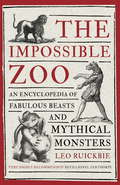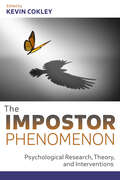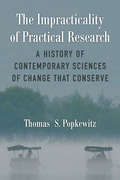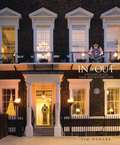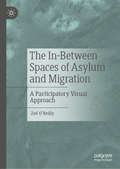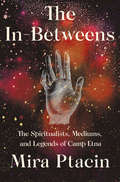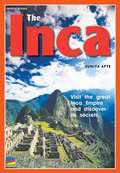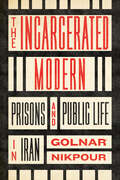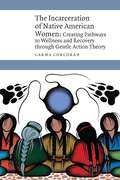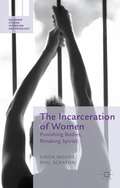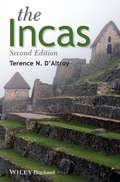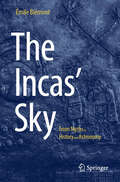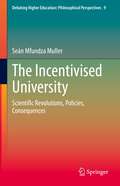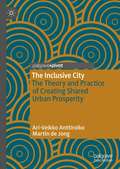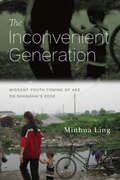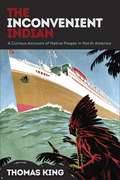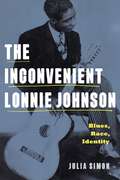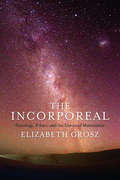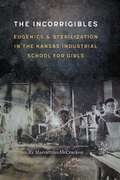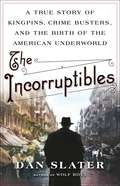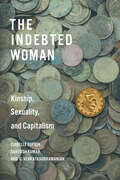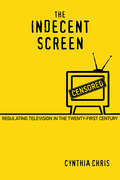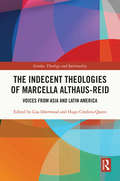- Table View
- List View
The Impossible Zoo: An encyclopedia of fabulous beasts and mythical monsters
by Leo RuickbieHERE BE DRAGONS!Here you will find the things that once made the woods wild and the nights to be feared; that made ancient map-makers write, 'Here be Dragons'.The Impossible Zoo is a biology of the supernatural - a study of the life of things that never lived. This world of mermaids and unicorns, now confined to fantasy, but once believed to exist, is a world of the imagination that still affects us today.Wonderfully illustrated throughout, it also provides sources as a guide to further study and exploration.'For anyone who has ever wished that dragons and unicorns were real, this magical, mystical and truly memorable book is definitely for you - and for me!'Dr Karl Shuker, author of A Manifestation of Monsters'Ruickbie's level of scholarship is impressive and he presents his conclusions with great literary skill in readable and attractive prose. The results are truly fascinating. Very highly recommended.'Revd Lionel Fanthorpe, FRSA, author and President of the Association for the Scientific Study of Anomalous Phenomena
The Impostor Phenomenon: Psychological Research, Theory, and Interventions
by Kevin CokleyThis book offers a scientific investigation into the impostor phenomenon, a concept that has long been misunderstood in popular culture. Much of the conventional wisdom about the impostor phenomenon is driven by intuitive, common-sense based recommendations about how to cope with and conquer impostor feelings. Unfortunately, much of this discourse is neither rooted in nor informed by empirical research. There are many important theoretical and methodological questions regarding the impostor phenomenon that remain unanswered, such as whether the impostor phenomenon is a personality trait at the core of one's identity, or merely a predisposition triggered by circumstances or fears of being evaluated. This book describes the theoretical underpinnings of the impostor phenomenon along with common measurement issues, implications for mental health and achievement, its relative prevalence among various population groups, and practical applications of the concept in psychotherapy and mental health treatment more broadly.
The Impostor Phenomenon: Psychological Research, Theory, and Interventions
by Kevin CokleyThis book offers a scientific investigation into the impostor phenomenon, a concept that has long been misunderstood in popular culture. Much of the conventional wisdom about the impostor phenomenon is driven by intuitive, common-sense based recommendations about how to cope with and conquer impostor feelings. Unfortunately, much of this discourse is neither rooted in nor informed by empirical research. There are many important theoretical and methodological questions regarding the impostor phenomenon that remain unanswered, such as whether the impostor phenomenon is a personality trait at the core of one's identity, or merely a predisposition triggered by circumstances or fears of being evaluated. This book describes the theoretical underpinnings of the impostor phenomenon along with common measurement issues, implications for mental health and achievement, its relative prevalence among various population groups, and practical applications of the concept in psychotherapy and mental health treatment more broadly.
The Impracticality of Practical Research: A History of Contemporary Sciences of Change That Conserve
by Thomas S. PopkewitzThere is an alluring desire that research should lead us to find the practical knowledge that enables people to live a good life in a just and equitable society. This desire haunted the 19th century emergence of the social sciences as a discipline, then became more pronounced in the postwar mobilizations of research. Today that desire lives on in the international assessments of national schools and in the structure of professional education, both of which influence government modernization of schools and also provide for people’s well-being. American policy thus reflects research in which reforms are verified by “scientific, empirical evidences” about “what works” in experiments, and “will work” therefore in society. The book explores the idea that practical and useful knowledge changes over time, and shows how this knowledge has been (re)visioned in contemporary research on educational reform, instructional improvement, and professionalization. The study of science draws on a range of social and cultural theories and historical studies to understand the politics of science, as well as scientific knowledge that is concerned with social and educational change. Research hopes to change social conditions to create a better life, and to shape people whose conduct embodies these valued characteristics—the good citizen, parent, or worker. Yet this hope continually articulates the dangers that threaten this future. Thomas Popkewitz explores how the research to correct social wrongs is paradoxically entangled with the inscription of differences that ultimately hamper the efforts to include.
The In & Out
by Tim NewarkThe Naval and Military Club--or the 'In & Out' as it is affectionately known--is one of Britain's greatest and oldest service clubs and this book tells its rich and entertaining history for the first time. Lavishly illustrated, it captures the essence of British style inside one of London's grandest clubhouses--first with a famous home in Piccadilly and now in St James's Square. Over 150 years, its members have included numerous Victoria Cross winners, triumphant generals and admirals, even bold explorers. There are intimate tales of brave soldiers and sailors--alongside a few rogues and accounts of scandalous behaviour!
The In-Between Spaces of Asylum and Migration: A Participatory Visual Approach
by Zoë O’ReillyBased on ethnographic research with asylum seekers living in a ‘direct provision’ centre in Ireland, and comprising participatory visual methods, this work offers a unique examination of the ‘direct provision’ system that analyses the tensions between exclusion and marginalization, and involvement and engagement with local communities. It gives voice to the perspectives of residents themselves through an analysis of photographic images and texts created by the participants of the project, providing fresh insight into the everyday experiences of living in these liminal zones between borders, and the various forms of attachment, engagement and belonging that they create. While the book’s empirical focus is on the Irish context, the analysis sheds light on broader policies and experiences of exclusion and the increasing number of liminal spaces between and within borders in which people seeking protection wait. Situated at the intersection of social anthropology, human geography and participatory arts and visual culture, it will appeal to scholars and students focusing on migration and asylum, ethnicity and integration, as well as those with an interest in participatory and visual research methods.
The In-Betweens: The Spiritualists, Mediums, And Legends Of Camp Etna
by Mira PtacinA young writer travels to Maine to tell the unusual story of America’s longest-running camp devoted to mysticism and the world beyond. <P><P> They believed they would live forever. So begins Mira Ptacin’s haunting account of the women of Camp Etna—an otherworldly community in the woods of Maine that has, since 1876, played host to generations of Spiritualists and mediums dedicated to preserving the links between the mortal realm and the afterlife. Beginning her narrative in 1848 with two sisters who claimed they could speak to the dead, Ptacin reveals how Spiritualism first blossomed into a national practice during the Civil War, yet continues—even thrives—to this very day. Immersing herself in this community and its practices—from ghost hunting to releasing trapped spirits to water witching— Ptacin sheds new light on our ongoing struggle with faith, uncertainty, and mortality. Blending memoir, ethnography, and investigative reportage, The In-Betweens offers a vital portrait of Camp Etna and its enduring hold on a modern culture that remains as starved for a deeper sense of connection and otherworldliness as ever.
The Inca: Text Pairs (Bridges/navigators Ser.)
by Sunita Apte Margaret McNamaraNIMAC-sourced textbook
The Incarcerated Modern: Prisons and Public Life in Iran (Stanford Studies in Middle Eastern and Islamic Societies and Cultures)
by Golnar NikpourIran's prison system is a foundational institution of Iranian political modernity. The Incarcerated Modern traces the transformation of Iran from a decentralized empire with few imprisoned persons at the turn of the twentieth century into a modern nation-state with over a quarter million prisoners today. In policing the line between "bad criminal" and "good citizen," the carceral system has shaped and reshaped Iranian understandings of citizenship, freedom, and political belonging. Golnar Nikpour explores the interplay between the concrete space of the Iranian prison and the role of prisons in producing new public cultures and political languages in Iran. From prison writings of 1920s leftist prisoners and communiqués of 1950s militant Islamists, to paintings of 1970s revolutionary guerrillas and mapping projects organized by contemporary dissident prisoners, carceral confinement has shaped modern Iranian political movements. Today, mass incarceration is a global phenomenon. The Incarcerated Modern connects Iranian history to transnational carceral histories to illuminate the shared architectures, economies, and techniques of modern punishment.
The Incarceration of Native American Women: Creating Pathways to Wellness and Recovery through Gentle Action Theory (New Visions in Native American and Indigenous Studies)
by Carma CorcoranIn The Incarceration of Native American Women, Carma Corcoran examines the rising number of Native American women being incarcerated in Indian Country. With years of experience as a case management officer, law professor, consultant to tribal defenders&’ offices, and workshop leader in prisons, she believes this upward trajectory of incarceration continues largely unacknowledged and untended. She explores how a combination of F. David Peat&’s gentle action theory and the Native traditional ways of knowing and being could heal Native American women who are or have been incarcerated. Colonization and the historical trauma of Native American incarceration runs through history, spanning multiple generations and including colonial wartime imprisonment, captivity, Indian removal, and boarding schools. The ongoing ills of childhood abuse, domestic violence, sexual assault, and drug and alcohol addiction and the rising number of suicides are indicators that Native people need healing. Based on her research and work with Native women in prisons, Corcoran provides a theory of wellness and recovery that creates a pathway for meaningful change. The Incarceration of Native American Women offers students, academics, social workers, counselors, and those in the criminal justice system a new method of approach and application while providing a deeper understanding of the cultural and historical experiences of Native Americans in relation to criminology.
The Incarceration of Women
by Linda Moore Phil ScratonThis unique book provides a rare insight into the debilitating impact of regimes that fail to respond to the complex and gender specific needs of women behind bars. Exploring the marginalization, mental health and experiences of women in prison, it specifically focuses on the legacy of women's imprisonment in Northern Ireland.
The Incas
by Terence N. D'AltroyThe Incas is a captivating exploration of one of the greatest civilizations ever seen. Seamlessly drawing on history, archaeology, and ethnography, this thoroughly updated new edition integrates advances made in hundreds of new studies conducted over the last decade.* Written by one of the world's leading experts on Inca civilization* Covers Inca history, politics, economy, ideology, society, and military organization* Explores advances in research that include pre-imperial Inca society; the royal capital of Cuzco; the sacred landscape; royal estates; Machu Picchu; provincial relations; the khipu information-recording technology; languages, time frames, gender relations, effects on human biology, and daily life* Explicitly examines how the Inca world view and philosophy affected the character of the empire* Illustrated with over 90 maps, figures, and photographs
The Incas' Sky: From Myths to History and Astronomy
by Émile BiémontThis book introduces readers to the astonishing civilisation of the Incas. Its novelty lies in its general but highly informative synthesis of their history and astronomy through the accounts of contemporary chronicles and recent archaeological findings. Richly illustrated with the author’s own photographs, it will attract the attention of seasoned travellers interested in ancient civilisations and keen to discover what people were capable of achieving so long ago, but also any reader interested in the history and prehistory of South American peoples, including students or university researchers wanting to know more about the pre-Columbian civilizations of Peru. The Inca civilisation was in fact the culmination of cultural contributions from a dozen or so complex pre-Columbian civilizations, such as those of Chavín, Nazca, Wari, or Tiwanaku. Intensely spiritual, the Inca people attributed metaphysical powers to all manner of objects and places they considered sacred, but at the same time the numerous alignments in their buildings show that they result from careful observations of the Sun, the Moon, and the stars at different times of the year. Indeed, the Incas were an essentially agrarian people, so time measurement and calendar devices were essential for the purely pragmatic problem of planning agricultural tasks during the tropical year. The book sets out to describe the Incas in their historical and geographical context, avoiding specialization or excessive technicality, but retaining a certain scientific rigor, and including a detailed consideration of their interest in the sky and astronomy.
The Incentivised University: Scientific Revolutions, Policies, Consequences (Debating Higher Education: Philosophical Perspectives #9)
by Seán Mfundza MullerThe core thesis of this book is that to understand the implications of incentive structures in modern higher education, we require a deeper understanding of associated issues in the philosophy of science. Significant public and philanthropic resources are directed towards various forms of research in the hope of addressing key societal problems. That view, and the associated allocation of resources, relies on the assumption that academic research will tend towards finding truth – or at least selecting the best approximations of it. The present book builds on, and extends, contributions in philosophy and higher education to argue that this assumption is misplaced: with serious implications for modern higher education and its role in informing societal decisions and government policy. The book develops a philosophical foundation for the analysis of the connection between higher education incentives, scientific progress and societal outcomes. That in turn is used to demonstrate how the current approach to incentivising intellectual and scientific progress is likely not only to fail, but in fact to cause harm on the very dimensions it purports to improve. The arguments presented are illustrated with examples from medicine and academic economics, making the book one of the first to examine issues of scientific progress and social consequences across the human and social sciences. In doing so, it develops a novel critique of modern economics that in turn provides a more philosophically substantive foundation for popular critiques of economics than has existed to date.
The Incident at Naples
by Francis SteegmullerBorn in Australia, novelist Shirley Hazzard first moved to Naples as a young woman in the 1950s to take up a job with the United Nations. It was the beginning of a long love affair with the city, in which the Naples of Pliny, Gibbon, and Auden constantly became reanimated by new experiences, as Hazzard was joined in her travels by her husband, the editor and critic Francis Steegmuller. In The Incident at Naples, a classic essay first published by the New Yorker, Steegmuller recollects on how he was, as a tourist to the city, robbed and injured and then treated in a series of hospitals. What can The Incident at Naples teach us? A town shadowed by both the symbol and the reality of Vesuvius can never fail to acknowledge the essential precariousness of life-nor, as Hazzard and Steegmuller discover, the human compassion, generosity, and friendship that are necessary to sustain it.
The Inclusive City: The Theory and Practice of Creating Shared Urban Prosperity
by Ari-Veikko Anttiroiko Martin de JongThis book provides a conceptual framework for understanding the inclusive city. It clarifies the concept, dimensions and tensions of social and economic inclusion and outlines different forms of exclusion to which inclusion may be an antidote. The authors argue that as inclusion involves a range of inter-group and intragroup tensions, the unifying role of local government is crucial in making inclusion a reality for all, as is also the adoption of an inclusive and collaborative governance style. The book emphasizes the need to shift from citizens’ rights to value creation, thus building a connection with urban economic development. It demonstrates that inclusion is an opportunity to widen the local resource base, create collaborative synergies, and improve conditions for entrepreneurship, which are conducive to the creation of shared urban prosperity.
The Inconvenient Generation: Migrant Youth Coming of Age on Shanghai's Edge
by Minhua LingAfter three decades of massive rural-to-urban migration in China, a burgeoning population of over 35 million second-generation migrants living in its cities poses a challenge to socialist modes of population management and urban governance. In The Inconvenient Generation, Minhua Ling offers the first longitudinal study of these migrant youth from middle school to the labor market in the years after the Shanghai municipal government partially opened its public school system to them. Drawing on multi-sited ethnographic data, Ling follows the trajectories of dozens of children coming of age at a time of competing economic and social imperatives, and its everyday ramifications on their sense of identity, educational outcomes, and citizenship claims. Under policies and practices of segmented inclusion, they are inevitably funneled through the school system toward a life of manual labor. Illuminating the aspirations and strategies of these young men and women, Ling captures their experiences against the backdrop of a reemergent global Shanghai.
The Inconvenient Indian: A Curious Account of Native People in North America
by Thomas KingIn The Inconvenient Indian, Thomas King offers a deeply knowing, darkly funny, unabashedly opinionated, and utterly unconventional account of Indian–White relations in North America since initial contact. Ranging freely across the centuries and the Canada–U.S. border, King debunks fabricated stories of Indian savagery and White heroism, takes an oblique look at Indians (and cowboys) in film and popular culture, wrestles with the history of Native American resistance and his own experiences as a Native rights activist, and articulates a profound, revolutionary understanding of the cumulative effects of ever-shifting laws and treaties on Native peoples and lands.Suffused with wit, anger, perception, and wisdom, The Inconvenient Indian is at once an engaging chronicle and a devastating subversion of history, insightfully distilling what it means to be &“Indian&” in North America. It is a critical and personal meditation that sees Native American history not as a straight line but rather as a circle in which the same absurd, tragic dynamics are played out over and over again. At the heart of the dysfunctional relationship between Indians and Whites, King writes, is land: &“The issue has always been land.&” With that insight, the history inflicted on the indigenous peoples of North America—broken treaties, forced removals, genocidal violence, and racist stereotypes—sharpens into focus. Both timeless and timely, The Inconvenient Indian ultimately rejects the pessimism and cynicism with which Natives and Whites regard one another to chart a new and just way forward for Indians and non-Indians alike.
The Inconvenient Lonnie Johnson: Blues, Race, Identity (American Music History)
by Julia SimonLonnie Johnson is a blues legend. His virtuosity on the blues guitar is second to none, and his influence on artists from T-Bone Walker and B. B. King to Eric Clapton is well established. Yet Johnson mastered multiple instruments. He recorded with jazz icons such as Duke Ellington and Louis Armstrong, and he played vaudeville music, ballads, and popular songs.In this book, Julia Simon takes a closer look at Johnson’s musical legacy. Considering the full body of his work, Simon presents detailed analyses of Johnson’s music—his lyrics, technique, and styles—with particular attention to its sociohistorical context. Born in 1894 in New Orleans, Johnson's early experiences were shaped by French colonial understandings of race that challenge the Black-white binary. His performances call into question not only conventional understandings of race but also fixed notions of identity. Johnson was able to cross generic, stylistic, and other boundaries almost effortlessly, displaying astonishing adaptability across a corpus of music produced over six decades. Simon introduces us to a musical innovator and a performer keenly aware of his audience and the social categories of race, class, and gender that conditioned the music of his time. Lonnie Johnson’s music challenges us to think about not only what we recognize and value in “the blues” but also what we leave unexamined, cannot account for, or choose not to hear. The Inconvenient Lonnie Johnson provides a reassessment of Johnson’s musical legacy and complicates basic assumptions about the blues, its production, and its reception.
The Incorporeal: Ontology, Ethics, and the Limits of Materialism
by Elizabeth GroszPhilosophy has inherited a powerful impulse to embrace either dualism or a reductive monism—either a radical separation of mind and body or the reduction of mind to body. But from its origins in the writings of the Stoics, the first thoroughgoing materialists, another view has acknowledged that no forms of materialism can be completely self-inclusive—space, time, the void, and sense are the incorporeal conditions of all that is corporeal or material. In The Incorporeal Elizabeth Grosz argues that the ideal is inherent in the material and the material in the ideal, and, by tracing its development over time, she makes the case that this same idea reasserts itself in different intellectual contexts.Grosz shows that not only are idealism and materialism inextricably linked but that this "belonging together" of the entirety of ideality and the entirety of materiality is not mediated or created by human consciousness. Instead, it is an ontological condition for the development of human consciousness. Grosz draws from Spinoza's material and ideal concept of substance, Nietzsche's amor fati, Deleuze and Guattari's plane of immanence, Simondon's preindividual, and Raymond Ruyer's self-survey or autoaffection to show that the world preexists the evolution of the human and that its material and incorporeal forces are the conditions for all forms of life, human and nonhuman alike. A masterwork by an eminent theoretician, The Incorporeal offers profound new insight into the mind-body problem
The Incorrigibles: Eugenics and Sterilization in the Kansas Industrial School for Girls
by Ry Marcattilio-McCrackenBetween September 1935 and June 1936, sixty-two girls from a reformatory in north-central Kansas were sterilized in the name of eugenics. None of the girls were habitual criminals, had multiple children, were living on social welfare, or were found to have IQs below seventy; in other words, almost none of them fit the categories usually described by eugenicists as justification for sterilization or covered by Kansas&’s eugenic sterilization law. Yet no one at the time—including the reform school superintendent who ordered the procedures performed—had trouble defending the sterilizations as eugenically minded. The general public, however, found the justifications significantly more controversial after the story hit the newspapers. In The Incorrigibles Ry Marcattilio-McCracken interrogates the overlooked history of eugenics in Kansas. He argues that eugenics developed alongside Progressive social welfare reforms in public health, criminal deterrence, child welfare, and juvenile delinquency. Between 1890 and 1955, ideas about rural degenerationism and hereditarianism infused the mission of &“progressive&” reformers, who linked delinquency, incorrigibility, and immorality to inheritable traits. Marcattilio-McCracken shows how the era&’s institutional overcrowding, landmark Supreme Court cases, and the economic downturn of the Great Depression contributed to the sterilization of the students from the Girls&’ Industrial School in Beloit, Kansas.
The Incorruptibles: A True Story of Kingpins, Crime Busters, and the Birth of the American Underworld
by Dan SlaterThis harrowing tale of early twentieth century New York reveals the true stories of an immigrant underworld, a secret vice squad, and the rise of organized crime. In the early 1900s, prior to World War I, New York City was a vortex of vice and corruption. On the Lower East Side, then the most crowded ghetto on earth, Eastern European Jews formed a dense web of crime syndicates. Gangs of horse poisoners and casino owners, pimps and prostitutes, thieves and thugs, jockeyed for dominance while their family members and neighbors toiled in the unregulated garment industry. But when the notorious murder of a gambler attracted global attention, a coterie of affluent German-Jewish uptowners decided to take matters into their own hands. Worried about the anti-immigration lobby and the uncertain future of Jewish Americans, the uptowners marshalled a strictly off-the-books vice squad led by an ambitious young reformer. The squad, known as the Incorruptibles, took the fight to the heart of crime in the city, waging war on the sin they saw as threatening the future of their community. Their efforts, however, led to unforeseen consequences in the form of a new mobster class who realized, in the country&’s burgeoning reform efforts, unprecedented opportunities to amass power. In this mesmerizing and atmospheric account, drawn from never-before-seen sources and peopled with unforgettable characters, Dan Slater tells an epic and often brutal saga of crime and redemption, exhuming a buried history that shaped our modern world.
The Indebted Woman: Kinship, Sexuality, and Capitalism (Culture and Economic Life)
by Santosh Kumar Isabelle Guérin G. VenkatasubramanianWomen, and particularly poor women, have become essential cogs in the wheel of financialized capitalism. Globally, women are responsible for managing household debt, and that debt has exploded over the last decade, reaching an all-time high after the COVID-19 pandemic. Across various categories of loans, including subprime lending, microcredit policies, and consumer loans, as well as rent and utilities, women are overrepresented as clients and managers, and are being enfolded into the system. The Indebted Woman discusses the crucial yet invisible roles poor women play in making and consolidating debt and credit markets. Isabelle Guérin, Santosh Kumar, and G. Venkatasubramanian spent over two decades observing a credit market that specifically targets women in the Indian countryside of east-central Tamil Nadu. They found that paying off debts required labor, frequently involved sexual transactions, and shaped women's bodies and subjectivities. Bringing together ethnography, statistical surveys, and financial diaries, they offer for the first time a comprehensive theory for this sexual division of debt that goes far beyond the Indian case, exposing the ways capitalism transforms womanhood and how this transformation in turn fuels capitalism.
The Indecent Screen: Regulating Television in the Twenty-First Century
by Cynthia ChrisThe Indecent Screen explores clashes over indecency in broadcast television among U.S.-based media advocates, television professionals, the Federal Communications Commission, and TV audiences. Cynthia Chris focuses on the decency debates during an approximately twenty-year period since the Telecommunications Act of 1996, which in many ways restructured the media environment. Simultaneously, ever increasing channel capacity, new forms of distribution, and time-shifting (in the form of streaming and on-demand viewing options) radically changed how, when, and what we watch. But instead of these innovations quelling concerns that TV networks were too often transmitting indecent material that was accessible to children, complaints about indecency skyrocketed soon after the turn of the century. Chris demonstrates that these clashes are significant battles over the role of family, the role of government, and the value of free speech in our lives, arguing that an uncensored media is so imperative to the public good that we can, and must, endure the occasional indecent screen.
The Indecent Theologies of Marcella Althaus-Reid: Voices from Asia and Latin America (Gender, Theology and Spirituality)
by Hugo Córdova Quero Lisa IsherwoodThis book celebrates the legacy of theologian Marcella Althaus-Reid (1952‑2009), and her particular influence in Asia and South America. Her work has served as a significant source of inspiration to many scholars, ministers, and activists challenging heteronormative theologies, but her sudden death in 2009 cut short the nascent and elegant theological thought for which she so valued. Contributors to this book succinctly investigate aspects of the vast work of Althaus-Reid by discussing issues of gender, race, and sexuality in Asia and South America, utilising the liberation, queer and indecent theologies she espoused. Each chapter demonstrates how her legacy is alive and thriving today, but also points towards to the potential future impact of her prolific theological output. By highlighting the ground-breaking work of Althaus-Reid, this book will serve as a key reference for scholars of Liberation, Queer and Indecent Theology, as well as Asian and Latinx religions.
